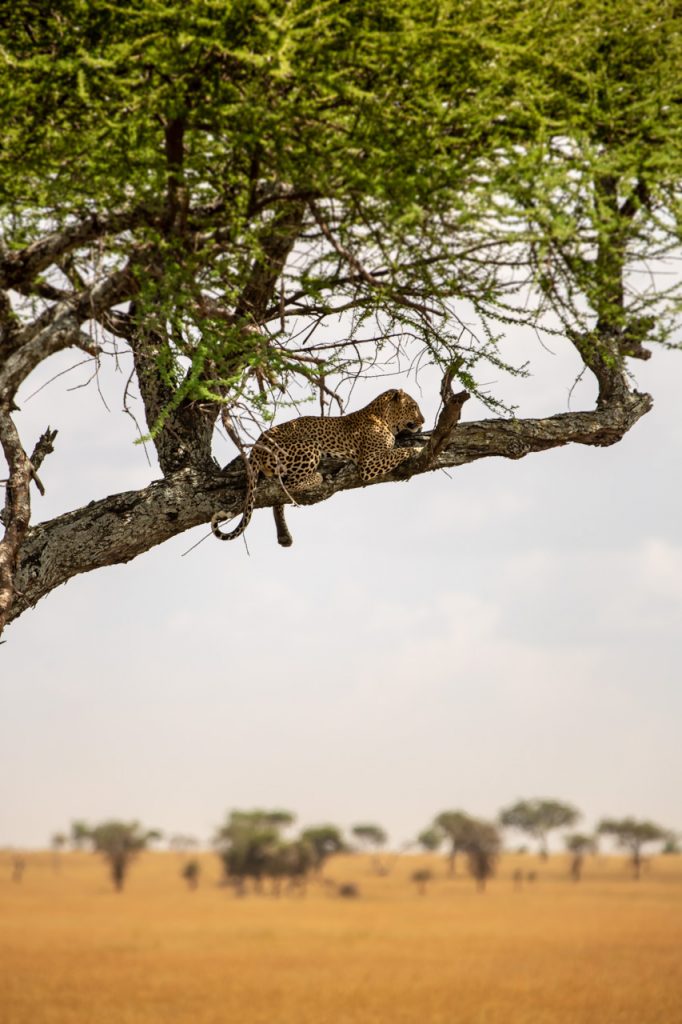With the world’s highest concentration of wildlife and magnificent landscapes Tanzania is justly one of the most popular safari countries. We set out with the dream of swopping TV-shows of National Geographic with the real thing and get up close with the fascinating wildlife of the savannah.
Written by Mette / Photo by Martin
The article has been published in Vagabond Travel Magazine, 2016
Translated from Danish
“Jambo jambo!” The kind greeting on Swahili comes from an African who has just parked a big green Toyota Land Cruiser in front of our hotel in the city of Moshi. He waves and walks towards us. On his white football jersey big blue letters writes Tanzania.
“You’re from Denmark? But you look Chinese,” he says and shakes my hand before saying hello to Martin. “My name is Zamo. I’m from Russia,” he says – and breaks into a contagious laughter that reveals a big gap between his front teeth. Only now we understand that he is joking. During the next seven days we become familiar with his whimsical sense of humor. Zamo is our guide and driver on a safari through northern Tanzania.
With a Hehe behind the wheel
Soon after we are on our way in the jeep, which has a custom build roof that can be raised easily to provide a free view of nature and animals. Today’s first spectacular view is of Kilimanjaro. With 5.895 meters above sea level it’s the highest mountain in Africa. The flat planes’ surrounding makes it a unique sight. Every year almost 50.000 people attempt to climb the iconic snowy top. But that’s not our mission on this trip. In front of us a 200 km long road trip to the city of Karatu awaits. It’s the starting point for tomorrow’s safari in Tarangire National Park.
Mile by mile the passing scenario is changing. Small villages with shops painted in strong colors, advertising signs and a myriad of people are replaced by lurching mountain scenery and endless flat plains. Occasionally a red-dressed Maasai pops up guarding his cattle in the scattered vegetation of grass, bushes and acacia trees, which resemble green wisps of cotton wool.
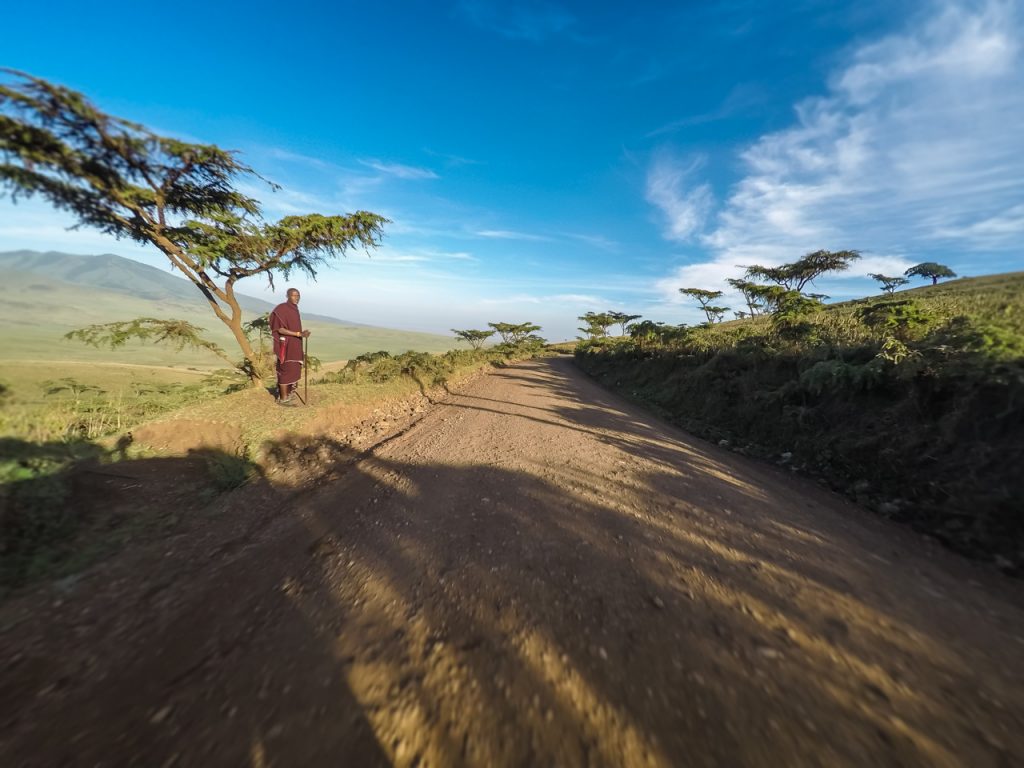
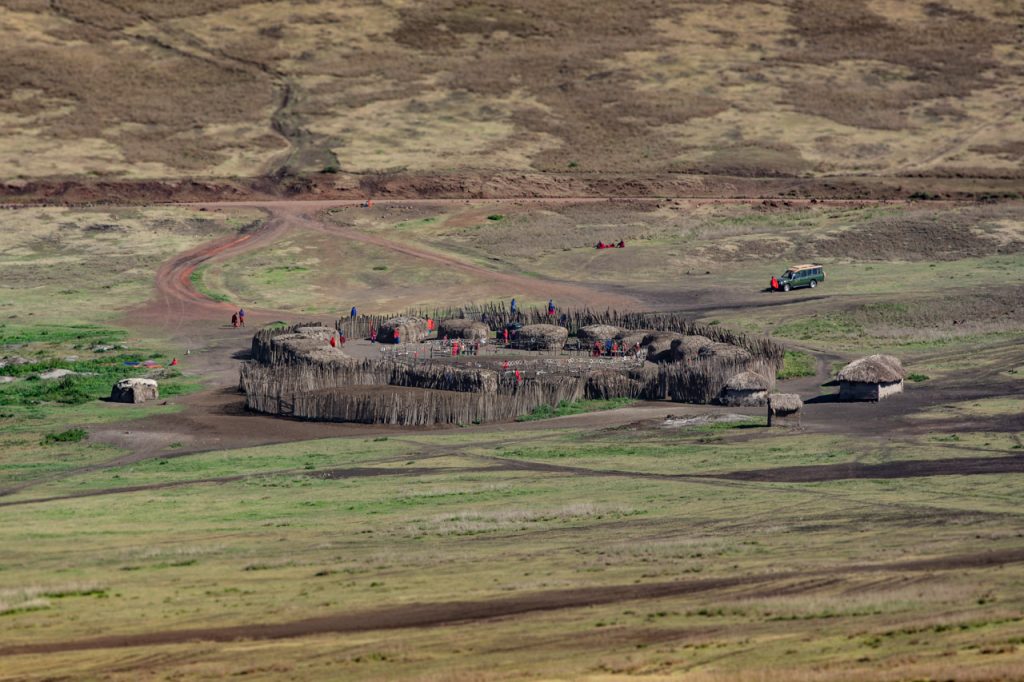
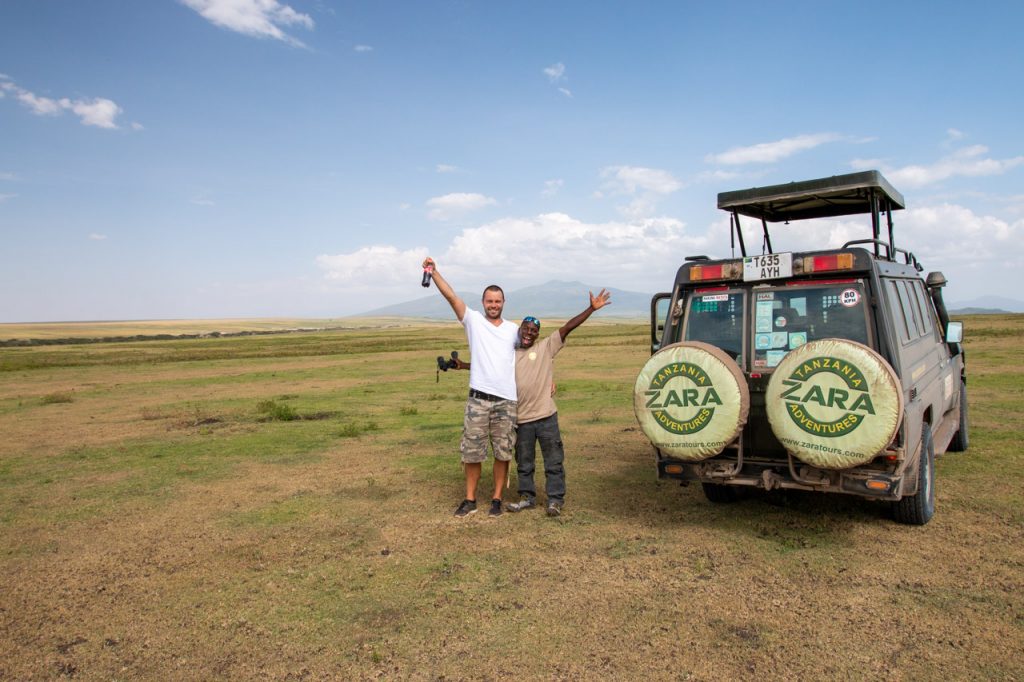
Above us the sun hangs on a cloudless sky and the horizon burns out in a fog of heat waves and dust. Tanzania’s vastness is wildly breathtaking and quite huge, 22 times bigger than Denmark, and home to more than 125 different tribes. It was only when the country was freed from the British colonial rule in 1961 that the leaders managed to gather the nation with a common language as a catalyst for peaceful coexistence. Today, most of the population speak Swahili and identify themselves as Tanzanians before they mention their tribal sense of belonging.
“He-he,” Zamo laughs, when we ask which tribe he belongs to. But it’s not a short laugh. It’s the name of his tribe. The name goes back hundreds of years when they met some strangers on the savannah and exclaimed: “Hehe!” To us it sounds like they found the encounter funny, but to the tribe of Hehe it means “Wow!”
Elephants upclose
Next morning we are welcomed at the Tarangire National Park by a huge baobab tree standing at the entrance of the park. The crown of the tree resembles a children’s drawing with crooked branches and the circumference of the trunk is so large that it would require 15-16 people to reach around it.
Tarangire is famous for its many baobab trees. The characteristic appearance and ability of the tree to become thousands of years old has made it one of Africa’s most legendary icons. And although the tree by nature is a generous creature that gives food and water to animals and humans it still has to put up with quite a lot of stuff. One old superstition says that if you drink water with the seeds of a baobab tree hungry crocodiles will not eat you. On the other hand – if you pick a flower from the tree you are guaranteed to be eaten by a lion.
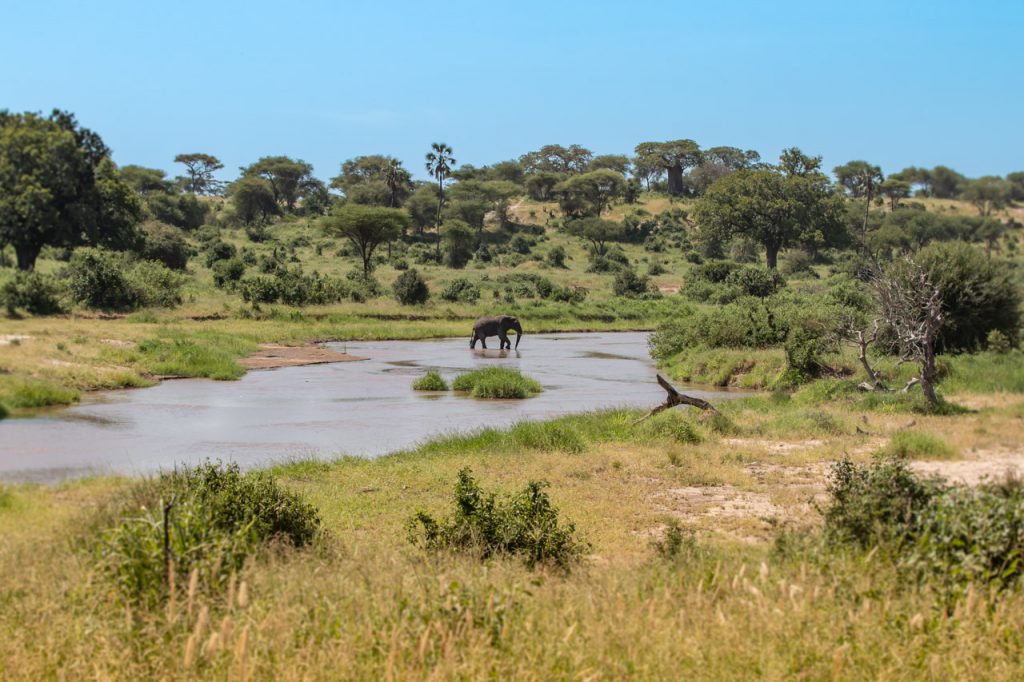
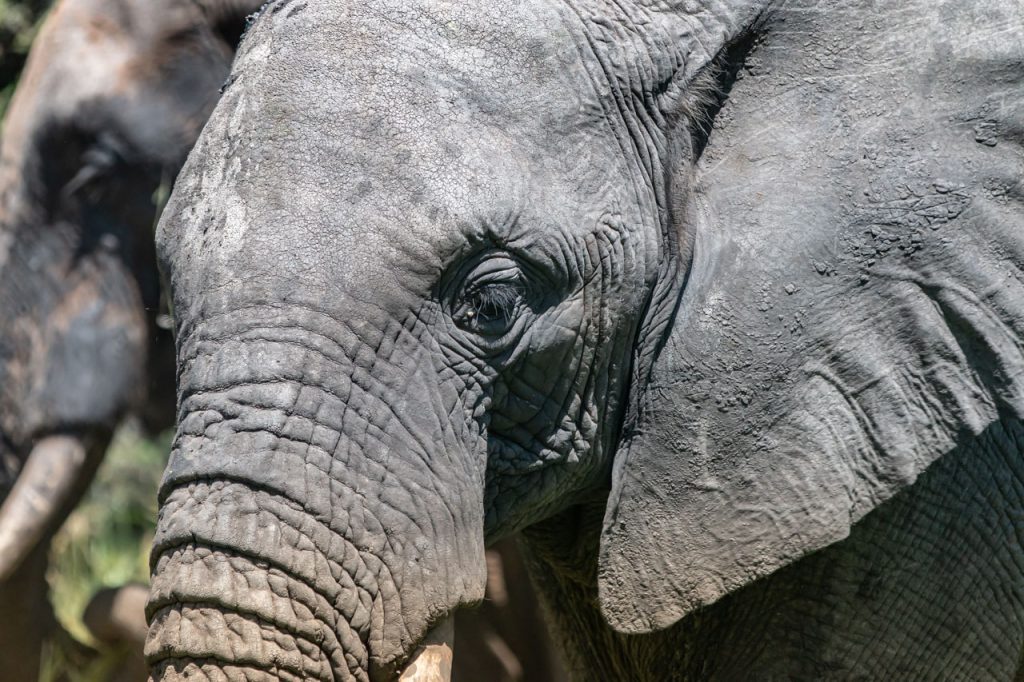
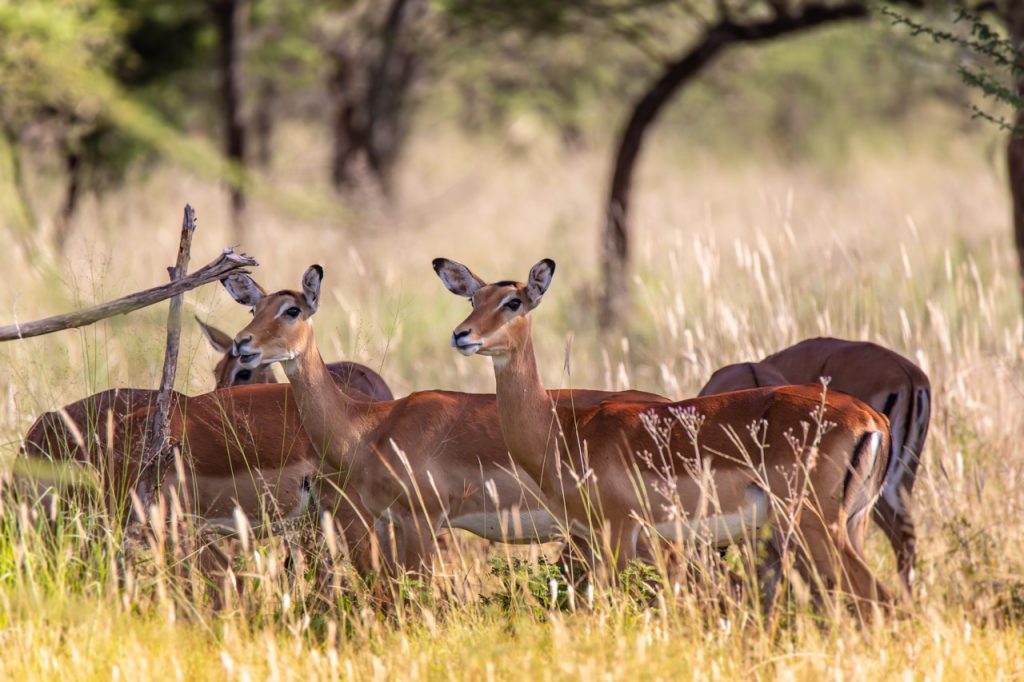
Perhaps we have been sprinkled with magic dust from the baobab tree, because during the day we experience a true African eldorado of wildlife. Only few meters from the car we experience a generous amount of: Bearded wildebeest, big buffalos, small dike antelopes, caramel-colored impalas, long-necked giraffes, striped zebras and not least the park’s biggest attraction the elephant. The sight of wild animals slowly pushing through the bush is a captivating experience.
But it’s not magic – it’s Tarangire. The park got its name after the river, which bends through the hilly landscape and supplies the animals with water all year round, which is the reason for the impressive concentration of animals. The river is the savannah’s version to flypaper and makes it surprisingly easy to see the animals.
Ruler of Serengeti
Next day we are high on excitement as we drive further west. On rough and dusty dirt roads, through Ngorongoro’s lush high plains where the Maasai people reside in small clay cottages, to Serengeti. The first sight of Africa’s most famous national park does not disappoint. Serengeti – means ‘endless plains’ in the language of Maasai and covers and area of 14.750 km² – unfolds like a champagne-colored rug. The view extends towards all four corners of the world and completely absorbs us.
Suddenly Zamo turns off the car. “You see it?” He asks and points in the direction of … nothing. We are surrounded by dry grass. But what we thought was a patch of dry grass turns out to be the mane of a male lion. The largest and strongest predator of the savannah. It slowly walks in our direction and settle on a small earthy top three meters from the car. The big white canines are exposed in the slightly open mouth of the lion and I feel the yellow eyes looking directly at me.
“Hakuna matata,” Zamo assures us, when we ask if we can close the roof of the car? (I’m happy to say that we have not picked a baobab flower). We are safe as long as we stay in the jeep. The lion can’t see or smell us, Zamo says and continues with a story about a woman who left the car to rearrange a litter of lion cubs to get a better pose for the camera. That was a bad idea.
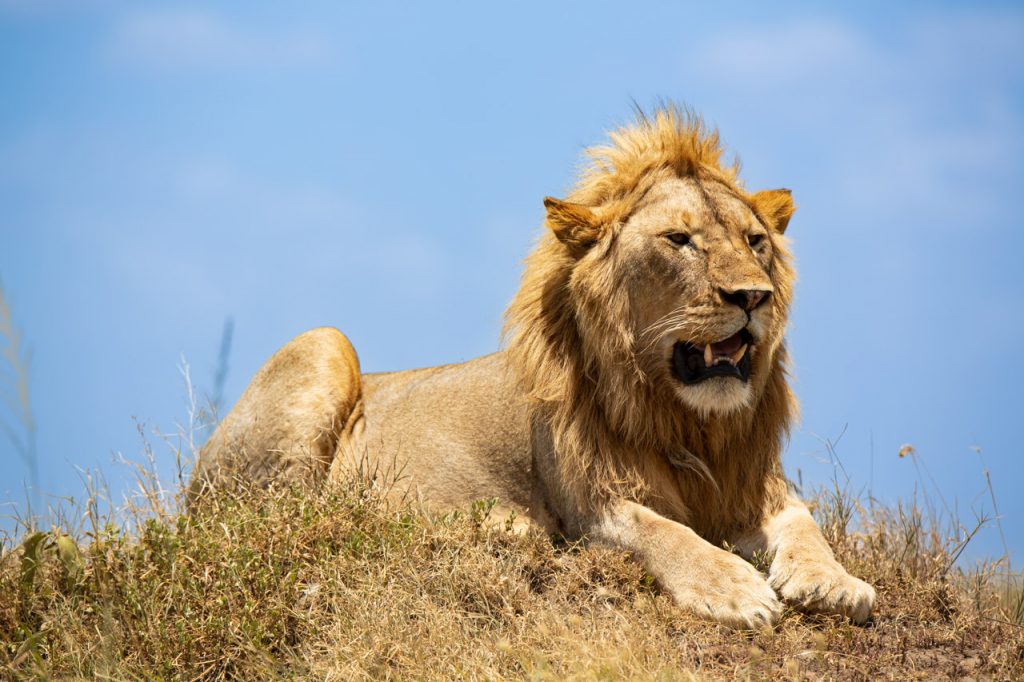
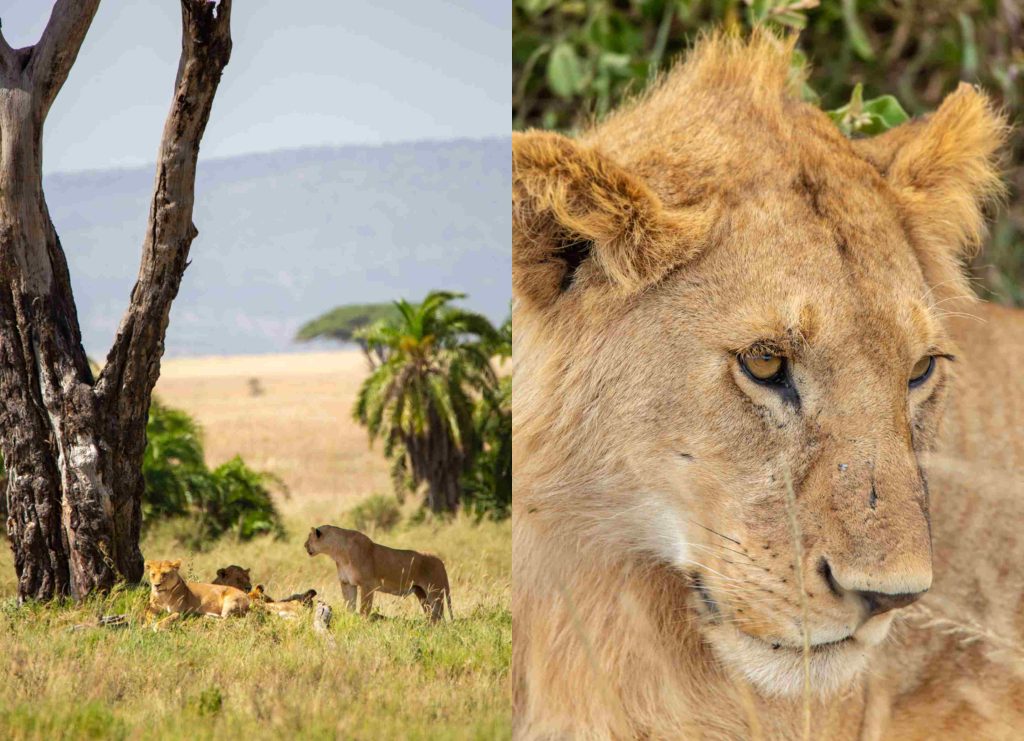
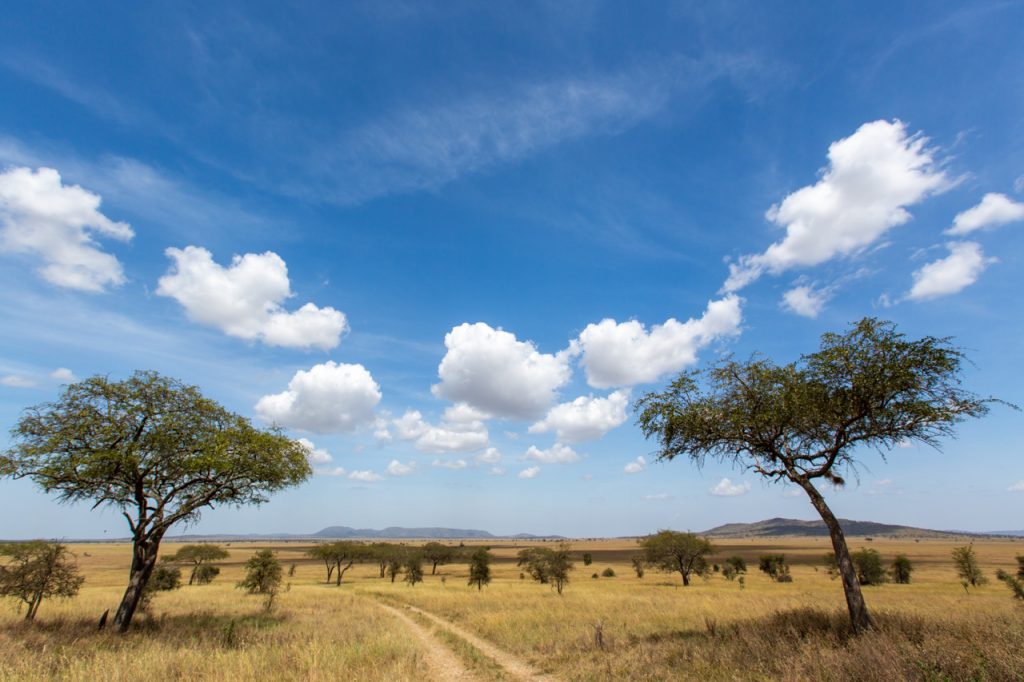
Camping on the Savannah
All day we are scouting for wildlife. “They eat anything – just like the Chinese,” Zamo laughs as we spot a leopard lying as a diva in a tree. Shortly after we almost ram in to a bunch of wild boars suddenly crossing the road with tails raised like radio antennas. And we have to hold back for two giraffes that slowly spread their long stilts to better reach the small pond running across the gravel road. A rare sight as the giraffe gets most of its fluid from the leaves of the trees.
The hippos we smell before we see them. The barrel-shaped animal slumber in a muddy lake filled with their own stools. The bad odor marks their territory, Zamo says – and adds the fun fact that even though a hippo can weigh up to three tons, it’s light as an astronaut on the moon when it’s under water.
As we arrive at our camp at the end of the day we only lack the rhino on the expanded list of the superstars of the savannah – called The Big Nine. The sun has gone to bed and the stars are slowly pocking small holes of light in the clear night sky. Which means that it is feeding time for all the predators. Therefore an armed guard escorts us to our tent for the night. After all we do sleep in the middle of the savannah with no fences. Devoutly listening to the nature just outside our luxurious canvas room we soon fall asleep.
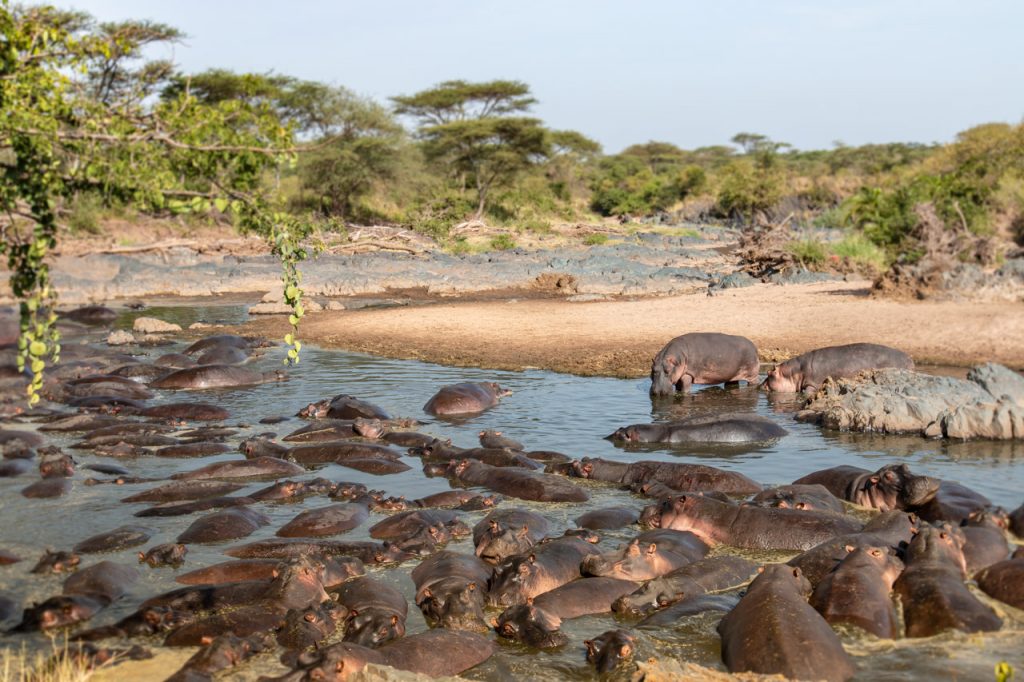
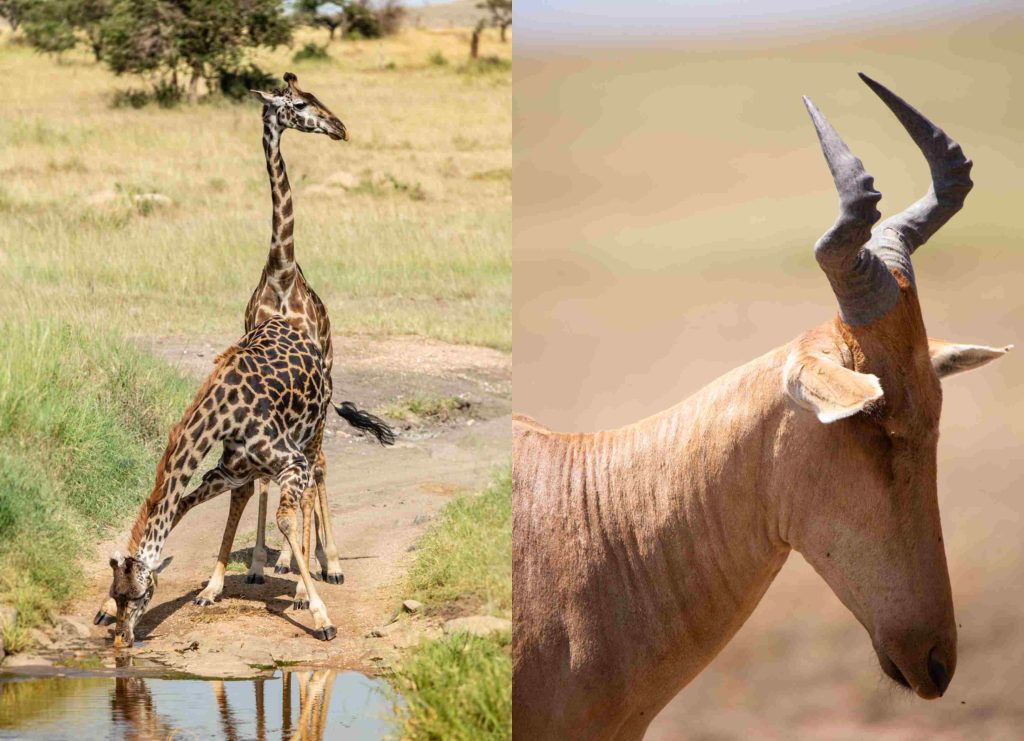
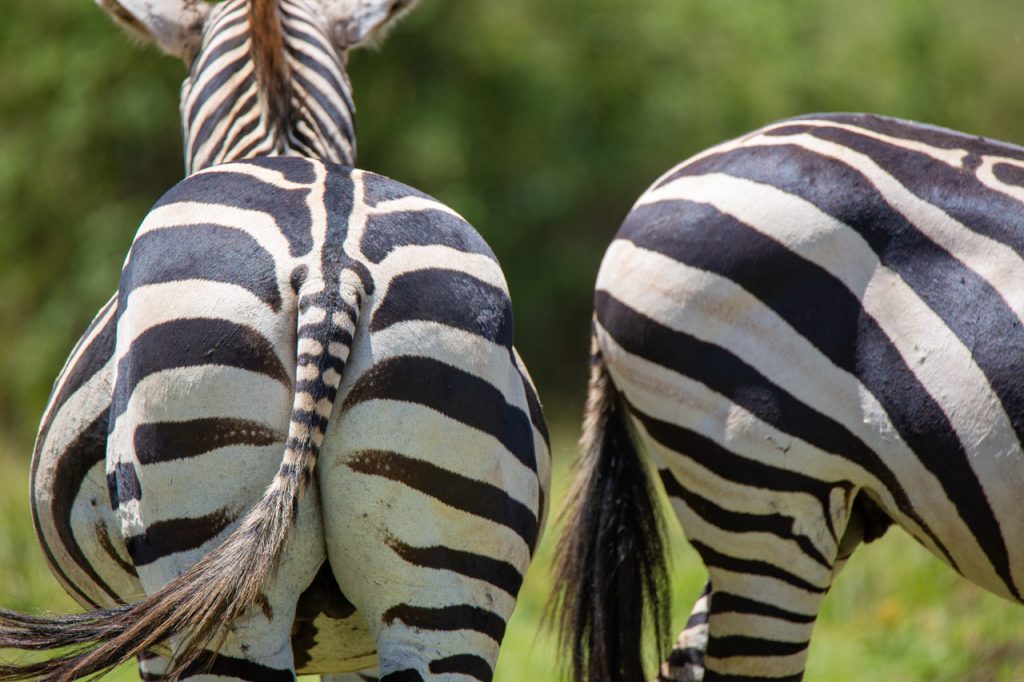
Ngorongoro – a dramatic paradise
No words are grand enough when we two days later stand on the edge of the Ngorongoro crater. At our feet the largest caldera in the world is revealed. The crater was created 2-3 million years ago when a volcano collapsed after a huge explosion. The crater is over 19 km from edge to edge. And inside the 260-km2 crater more than 20.000 animals resides in an unusual density. The place is beyond surreal.
It’s like arriving at a lost paradise as we drive down the steep craters to the lush and almost pancake shaped bottom. Side by side all the animals are grazing. Only the giraffes smiles from a distance, as there are no trees they can eat in the open landscape in front of us.
But even in paradise we are reminded that life is also bloody serious. We are being pushed back in the seat as Zamo suddenly pushes the pedal to the metal. In the horizon a bunch of hyenas are running and our guide has a sense of what’s going on. The hyenas laugh hysterically. In front of them a young wildebeest is fighting for its life, but the thin legs collapse as a big hyena drops the strongest bite of the savannah into its leg. A dust cloud rises. Everybody in the car holds his or her breath. The hunt is over. Covered in blood the hyenas triumphantly fill the air with their strange laugh while tearing the small animal into pieces. Shortly after the soundtrack is replaced by sounds of crushing bones.
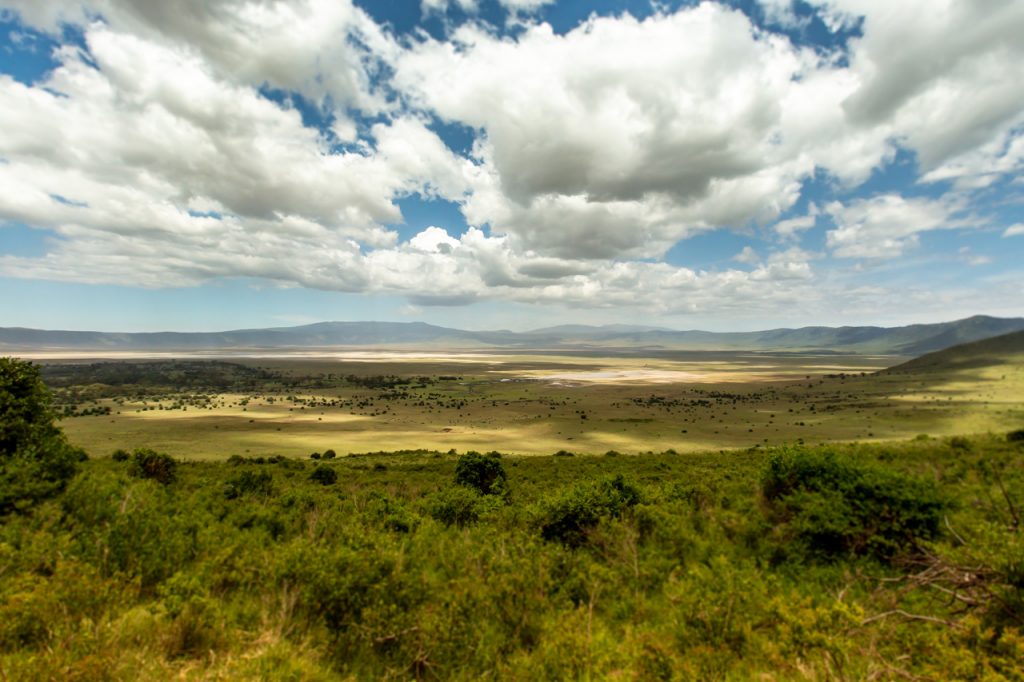
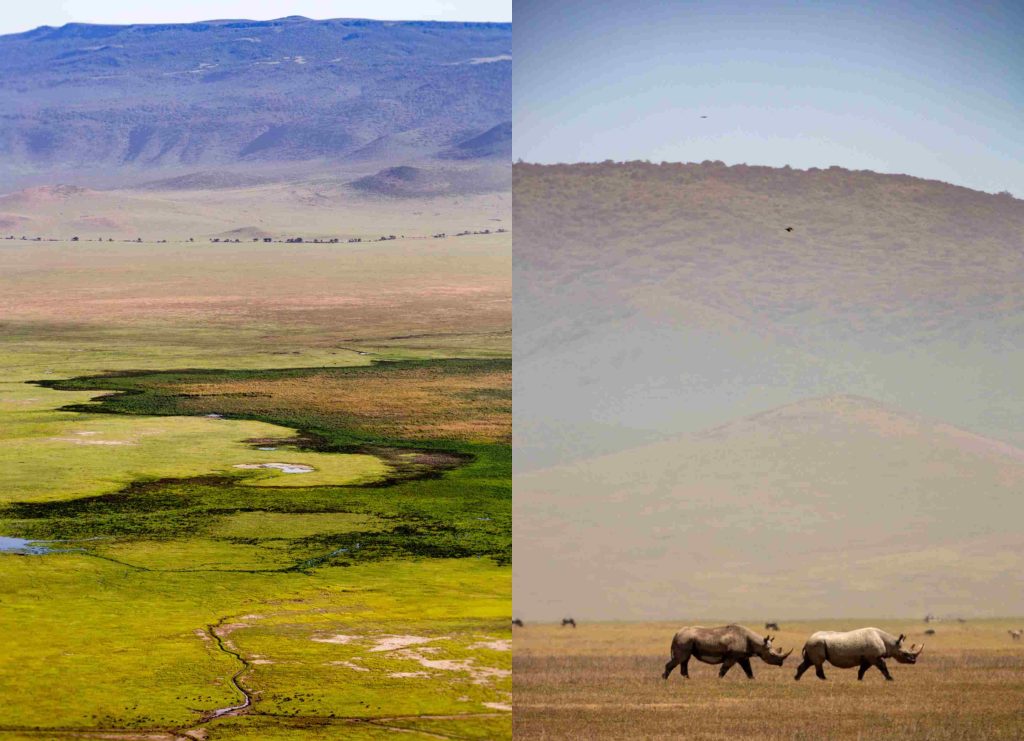
To cap it all
The atmosphere instantly changes in the car as we notice two black rhinos on the horizon. In 1970 there were 70.000 black rhinos in Africa. Today there are less than 500 left in East Africa, of which 20 of them resides in Ngorongoro.
With an almost cinematic ability to zoom in on the events, Zamo maneuver the jeep closer to the shy giants. While narrating like legendary David Attenborough. He tells how the crater acts as a natural and protective fencing. The earthly bowl allows the park rangers to guard the highly endangered animals.
We are now less than 100 meters from the grazing rhino when Zamo stops the car. The engine noise is replaced by sounds of birds. One rhino looks up. The other follows. “Hurry,” Zamo silently orders us. The armored animals start walking. And for a split second we feel like true big game hunters as we stick our head out of our shells, through the open roof. Aims on the pray and loosens a rain of shots with the camera. The experience is intoxicating. The Big Nine is in the box.
On the last of seven days we sadly say goodbye to Zamo at the entrance to Kilimanjaro Airport. We are missing a remote control with a replay button. We are not ready to go home. Tanzania has gone into our blood.
Fortunately a new adventure is waiting – six days on the island of Zanzibar. And already at the approach it is clear why the island is called the jewel of Tanzania. From the plane window we can see how the pearly white sandy beaches surround the lush island as a shining glory in the turquoise blue water. Not even sky-high superlatives are adequate here. Instead I will resort to Zamo’s tribal language and exclaim: “Hehe!”
